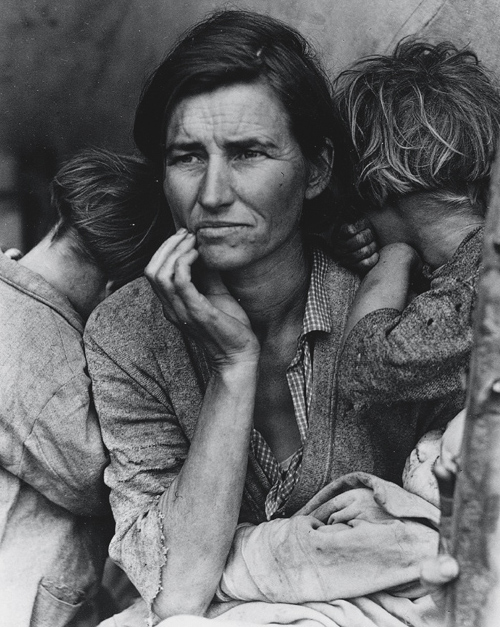STRATEGIES FOR CREATING AN EFFECTIVE VISUAL ARGUMENT
• Visual argument is immediate and tangible and pulls you into the picture by evoking an emotional response.
Visual argument is immediate and tangible and pulls you into the picture by evoking an emotional response.
Ever heard the phrase a picture is worth a thousand words? Visual argument often relies heavily upon an appeal to pathos and will typically communicate its message quickly, immediately evoking an emotional response from the viewer. If you are a fan of movies, you may have experienced this before. While viewing a film, one may often have the experience of sharing or taking part in the action along with the main character. Your experience with a still image may be similar. These images have a sense of immediacy and timelessness and pull you into the experience of the photo.
Consider Sudanese Girl below by Kevin Carter. It invites strong emotional responses. What is the question at issue here? What issues does it raise for you? What is Carter’s claim in the photo?
• Visual argument often establishes common ground and invites viewer identification and invites unique interpretations from viewers.
Visual argument often establishes common ground and invites viewer identification and invites unique interpretations from viewers.
Visual argument often creates a sense of personal identification with characters, the action, or the scene (and will do so more quickly than a written document). All viewers, however, may not experience the same degree of common ground or the same type of identification. This, of course, will vary from individual to individual as a result of our individual life experiences. Because of these unique experiences viewers fill in some of the meanings based upon our individual associations with objects and situations depicted.
Consider the photograph below by Dorothea Lange, Migrant Mother. With whom do you identify in this picture? The mother or the children? What are you own unique experiences and associations that you bring to this photo? What is the question at issue here? What position do you take on it?
• Visual argument often relies upon the juxtaposition of materials of radically different categories, inviting the viewer to make new links and associations. In placing objects, people, or actions that are not usually associated with one another in a common context, a photographer invites the viewer to establish new associations and even to reach new conclusions.
Visual argument often relies upon the juxtaposition of materials of radically different categories, inviting the viewer to make new links and associations. In placing objects, people, or actions that are not usually associated with one another in a common context, a photographer invites the viewer to establish new associations and even to reach new conclusions.
• Visual argument often employs icons to prompt an immediate emotional response.
Visual argument often employs icons to prompt an immediate emotional response.
Icons are images that people have seen so often that they respond to them
Immediately and in predictable ways—or at least, that is what people who include them in visual argument rely on. Examples would be the American eagle, the golden arches of McDonald’s, the Nike swish logo, the cross and the Star of David.
The image below may be one that you are very familiar with for it was broadcast in print and on television heavily at the beginning of the Iraq war. Are there icons present in this photo? What juxtapositions do you see?
• Visual arguments often employ symbols. Not all symbols are so familiar that they can be classified as icons. Consider the photograph by Mary Ellen Mark below titled The Damm Family in Their Car. What symbolic meaning does the car convey in this context? Is the blurred road in the background symbolic as well?
Visual arguments often employ symbols. Not all symbols are so familiar that they can be classified as icons. Consider the photograph by Mary Ellen Mark below titled The Damm Family in Their Car. What symbolic meaning does the car convey in this context? Is the blurred road in the background symbolic as well?
• Visual argument is selective. Whenever you look at a visual argument, you should also consider what is not in the frame of the image. If you could stand back and see the entire scene, of which the picture is only a small part, you perception of the picture may change a great deal. Instead you are only allowed to see what the photographer wants you to see. Consider the photo once again of the falling Saddam statue above. What may have been going on outside the frame of that photo? How would that change the claim of that visual argument.
Visual argument is selective. Whenever you look at a visual argument, you should also consider what is not in the frame of the image. If you could stand back and see the entire scene, of which the picture is only a small part, you perception of the picture may change a great deal. Instead you are only allowed to see what the photographer wants you to see. Consider the photo once again of the falling Saddam statue above. What may have been going on outside the frame of that photo? How would that change the claim of that visual argument.



